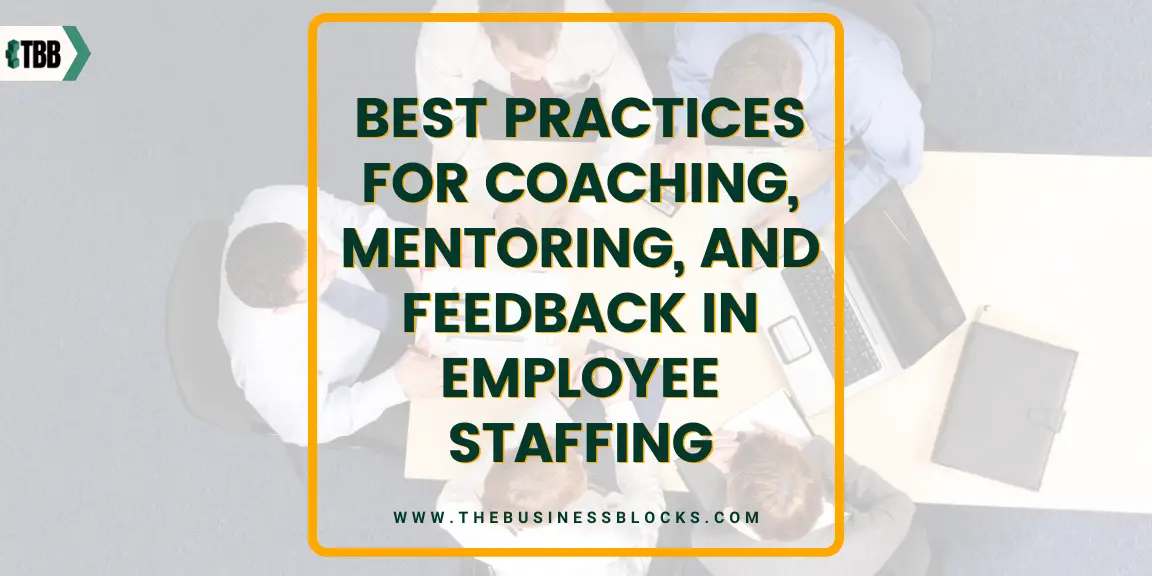Coaching, mentoring, and feedback have become buzzwords in employee staffing and performance management circuits. These approaches have gained appeal as effective instruments for maximizing human potential and driving corporate success.
In this guide, we’ll talk about how these concepts are more than corporate buzzwords and play a key role in any business’s success. Let’s start by understanding the importance of coaching, mentoring, and feedback in employee staffing.
Are you looking to improve the performance of your team?
Coaching, mentoring, and feedback are key elements in successful performance management. Whether you’re a manager or an employee, understanding best practices in each of these areas can help ensure the overall success of your team.
With employee coaching, they can learn new skills and develop confident decision-making capabilities to benefit their career development and contribute to organizational growth. By incorporating mentoring into the process, employees also get personalized guidance as they look for creative solutions to challenges within the workplace.
The Importance of Coaching, Mentoring, and Feedback in Employee Staffing

In 2023, companies must understand the importance of coaching, mentoring, and feedback in nurturing talent, fostering growth, and unlocking organizational potential. Let’s explore how these practices shape professional development and contribute to organizational success:
Coaching: It’s a supportive process that enhances skills, knowledge, and performance, empowering employees to reach their full potential. Coaching fosters growth, boosts confidence, and improves job performance.
Mentoring: Experienced mentors guide and support less experienced employees, sharing wisdom and helping them navigate their careers. Mentoring offers networking opportunities and exposure to different perspectives.
Feedback: Valuable information on performance and improvement areas. It helps employees understand strengths, identify development areas, and foster continuous learning and growth.
Best Practices for Coaching, Mentoring, and Feedback in Employee Staffing

In this section, we’ll look at the best practices for coaching, mentoring, and feedback in employee staffing. While some of these practices are intuitive, others take more time to understand.
Here are the five best practices for coaching and mentoring in employee staffing:
Creating a Positive Environment
Foster a supportive and inclusive environment where individuals feel comfortable and motivated to learn and grow. Encourage collaboration, respect diverse perspectives, and promote a culture of trust and psychological safety.
Making Goals Clear and Measurable
Establish clear and specific goals that align with organizational objectives. Ensure measurable goals allow employees to track their progress and understand expectations. This clarity helps individuals stay focused and motivated.
Encouraging Open Communication
Cultivate a culture of open and honest communication. Encourage regular discussions between employees and their coaches or mentors. Promote active listening, empathy, and effective feedback exchange to foster understanding and growth.
Providing Constructive Feedback
Offer timely and constructive feedback to support employee development. Focus on specific behaviors, provide actionable suggestions, and emphasize strengths and areas for improvement.
Acknowledging Successes and Celebrating Achievements
Recognize and celebrate employee successes and achievements. Regularly acknowledge their progress and efforts, both privately and publicly. This boosts morale, reinforces positive behavior, and encourages continuous improvement.
Components of a Successful Employee Staffing System

A successful system has a few important components regarding employee staffing. Let’s break them down:
Recruitment: This is finding and attracting qualified candidates for job openings. It involves creating job postings, advertising them, and conducting interviews. Think of it as casting a wide net to find the right people for the job.
Selection: Once you have applicants, the selection process helps you choose the best fit for the job. It involves evaluating candidates based on their skills, qualifications, and compatibility with the company’s values and culture. It’s like picking the perfect puzzle piece that fits just right.
Onboarding: Onboarding begins after a candidate is chosen. It is the process of greeting new employees and assisting them in adjusting to their new jobs and the organization. It is part of orientation, training, and getting them up to speed on their responsibilities. Similarly, it’s like greeting them and showing them the ropes.
Performance Management: This is all about managing and evaluating employee performance. It involves setting goals, providing feedback, and helping employees grow and develop. Think of it like being a coach, cheering them on, and helping them improve their skills.
Retention and Engagement: Keeping employees happy and motivated is important, so companies put effort into retaining and engaging their staff. This includes providing opportunities for growth, recognizing achievements, and creating a positive work environment.
The Pros and Cons of Employee Staffing Software

Like any technology solution, employee staffing software has pros and cons. Let’s explore them:
Pros:
Efficiency: Staffing software automates various tasks, such as job posting, candidate screening, and interview scheduling. It streamlines the hiring process, saving time and effort for recruiters and HR professionals.
Improved Candidate Experience: With staffing software, candidates can easily apply for jobs online, upload their resumes, and track their application status. This enhances the candidate experience and demonstrates a modern and tech-savvy approach to recruitment.
Data Analytics: Many staffing software solutions offer reporting and analytics capabilities. Recruiters can gain valuable insights into hiring metrics, such as time-to-fill, source effectiveness, and candidate quality. This helps in making data-driven decisions and optimizing the hiring process.
Cons:
Cost: Employee staffing software often comes with a price tag. Depending on the features and complexity, the cost of implementing and maintaining the software may be a concern for organizations with limited budgets.
Learning Curve: Introducing new software means employees must learn and adapt to the system. Training may be required to ensure effective use of the software, and some may require more time to become proficient in using it.
Technical Issues: Staffing software can experience glitches or downtime like any technology. This can disrupt the hiring process and create frustration among recruiters and candidates.
Tips for Effective Coaching, Mentoring, and Feedback in Employee Staffing
To sum up, everything we’ve discussed until now, here’s a checklist of the best tips for effecting coaching, mentoring, and feedback in employee staffing:
- Establish clear objectives.
- Build trust and rapport.
- Practice active listening.
- Provide constructive feedback.
- Encourage self-reflection.
- Offer guidance and support.
- Celebrate achievements.
- Schedule regular check-ins.
- Lead by example.
- Continual learning.
From coaching skills to developing meaningful relationships with employees, the tips above will help guide managers and supervisors in providing an effective environment for employee staffing. Organizations can set their teams up for success and create positive change with consistent support and feedback.
By taking the time to implement these best practices, they will surely see great results from their team. Employees’ work and the team’s success will directly result from the strong leadership and investment in their staff.
How to Determine the Success of Coaching, Mentoring, and Feedback in Performance Management

Measuring the results is important to determine the success of coaching, mentoring, and feedback in performance management. Measuring outcomes can help identify areas that need improvement and gauge progress toward goals.
Here are some tips to assess the success of coaching, mentoring, and feedback:
- Evaluate Goals: Evaluate employee performance against stated goals to see if they have been reached. Review the objectives regularly to track progress and make adjustments if needed. Hold employees accountable for their progress and own performance.
- Examine Feedback: Assess the quality of feedback provided by coaches, mentors, and managers. Does it help employees develop new skills or knowledge? Is it providing useful insights? Is it helping them become more productive or efficient? Encourage employees to provide feedback, so you can better understand their perspective.
- Monitor Progress: Track employee progress over time. Regularly check in with employees to see their progress and where they might need additional support. Analyze data to measure the effectiveness of coaching and mentoring approaches used by management. Coaching techniques or coaching style should be adjusted to best fit the individual needs of each employee.
- Measure Engagement: Measure employee engagement through surveys or other methods. Are employees feeling supported in their roles? Do they feel motivated and inspired to do their best work? Determine how successful coaching, mentoring, and feedback strategies are at improving morale and productivity.
- Observe Behavior: How employees respond to coaching, mentoring, and feedback. Good coaches improve performance by inspiring employees to take ownership of their work and develop new skills. Observe how coaches interact with team members and see if they are progressing in the right direction.
- Analyze Results: Measure the results of performance management initiatives such as employee retention and engagement. Are employees staying with the company longer or leaving early? Analyze data to determine if coaching, mentoring, and feedback are having a positive impact.
Performance management is an ongoing process that requires dedication and commitment from everyone involved. Evaluating success can help you adjust your approach so employees reach their potential. With the right strategies, coaching employees with constructive feedback and mentoring can effectively boost performance.
Frequently Asked Questions Coaching, Mentoring, and Feedback in Employee Staffing.
Q: How often should coaching and mentoring sessions be conducted?
A: Frequency varies based on needs. Regular check-ins (e.g., monthly or quarterly) provide ongoing support, feedback, and guidance.
Q: How to give constructive feedback without demotivating?
A: Focus on behaviors and outcomes, not personal attributes. Be specific, provide examples, and offer improvement suggestions. Deliver feedback respectfully, emphasizing growth.
Q: What if an employee resists coaching and feedback?
A: Some initial resistance is common. Create a safe environment for open communication. Address concerns, highlight benefits, and provide support to overcome challenges.
Q: Why positive feedback and employee ideas are important?
A: Positive feedback reinforces desired behaviors and motivates employees. Recognizing ideas and contributions is important, boosting morale and encouraging creativity.
Q: Do coaching conversations affect the effective coach to valuable members?
A: Yes. Having meaningful conversations and active listening helps build relationships, trust, and understanding between the coach and employees. This helps to foster a productive and positive environment.
Conclusion
Successful coaching, mentoring, and feedback initiatives should be part of onboarding for any new or existing employee or team member. It also provides an opportunity to identify team members who may require more support and coaching while recognizing those who excel in their roles and pushing them to reach higher performance levels. Coach employees, while expectations are set and holding them accountable for delivering results in line with identified outcomes, can promote a positive workplace environment while increasing overall productivity.
Coaching, mentoring, and feedback are indispensable components in employee staffing. With this guide, you can effectively create a coaching and mentoring program for your employees and witness organizational and personal growth.

